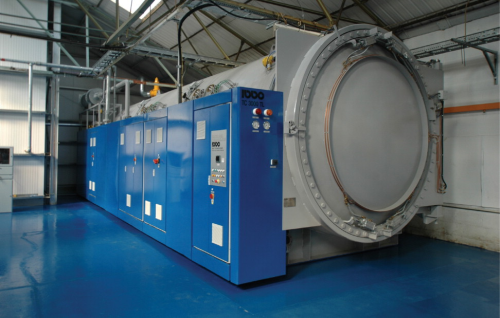
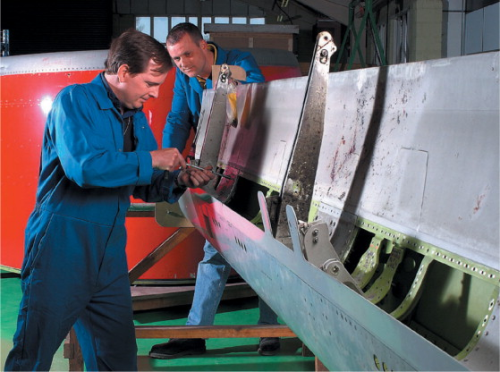
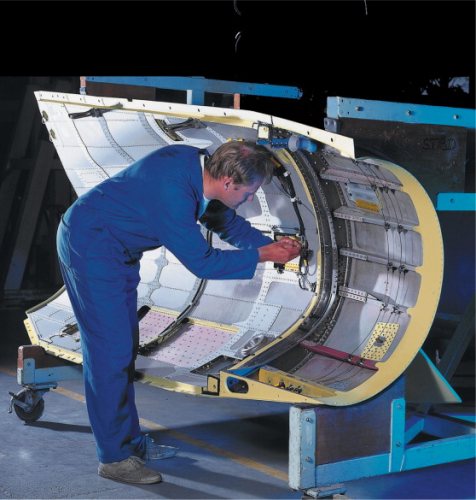
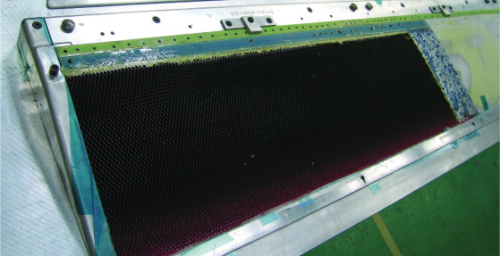
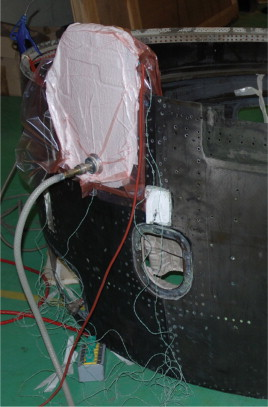
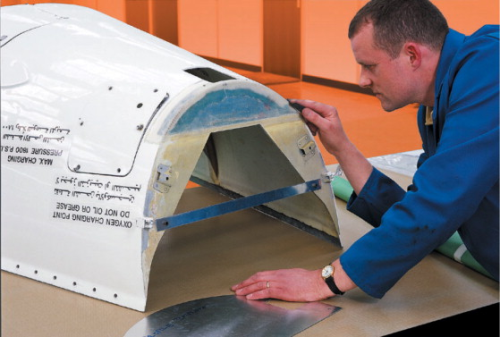
It's a typical day in the Christchurch, UK, facility of Beagle Aerospace. A technician is carefully placing plies of carbon and glass fibre, along with adhesive film and a shaped piece of core, into a void in a composite component. The void was left after removal of a section of laminate damaged originally when a ‘cherry picker’ had collided with an aircraft on an airport tarmac, leaving one of its engine thrust reversers decidedly the worse for wear. The impact had fractured both inner and outer composite skins of the reverser's outer sliding cowl, and the outer skin had been pushed through the core and inner skin.
After the thrust reverser had been removed from its nacelle and sent to the Christchurch facility for repair, the damaged portion had to be sprung back through and pinned to restore the outer surface to allow a local bonding tool to be formed. Next, the damaged skins and inner core had been removed over an area approximately 8 inches by 5 inches (around 20 cm by 13 cm). Both skins were cleaned and the surrounding paint finish removed over about 24 inches by 12 inches (60 cm by 30 cm). Each skin, inner and outer, had then been taper-sanded to form a chamfered ‘bed’ for the repair plies. Several extended drying cycles had been undertaken under infra-red lamps to remove oil spot contamination from the inner skin and absorbed moisture that might otherwise have proved troublesome when heated during bonding.
In building up the replacement plies and core, the technician will have to undertake four separate lay-up, vacuum bagging and bonding operations to complete the laminate, equating to some 30 layers in all. The cured part will then be finished to the original paint specification.
Meanwhile, other Beagle staff are also having to repair a metal bulkhead that suffered buckling damage in the collision. Then the repair team will have to reassemble the cowl to the main structure and make final adjustments before signing off the thrust reverser cowl as ready for returning to the client.
This repair illustrates the growing importance in the aircraft maintenance, repair and overhaul (MRO) field of being able to repair composite as well as traditional metal aerostructures. The need is growing as airframers, both civil and military, increasingly exploit composites to reduce aircraft weight. Aircraft performance is an important driver for this, although these days the need to save fuel and cut emissions is often equally, or more, important. The trend explains Beagle Aerospace's eagerness to grow its composites capability as a complement to its long entrenched expertise in metal.
History
Aviation sheet metal work has taken place at Beagle's Christchurch, Dorset, site on the UK's south coast for the last half century. Forerunner company at the site, CF Taylor Ltd, dealt with leading aviation prime contractors such as Rolls-Royce and entities that were later absorbed into British Aerospace (subsequently BAE Systems). Many of those relationships endure to this day and account for a substantial proportion of the present company's revenue. The Beagle name harks back to when CF Taylor acquired some of the assets of the Beagle Aircraft Company after the British light aircraft manufacturer was liquidated in the early 1970s. CF Taylor chose not to capitalise on the respected Beagle brand at the time, opting instead to continue trading under its own name while focusing on its metal aerostructures repair (mainly) business.
It was not until several owners later, when the Christchurch enterprise became part of Smiths Aerospace, that the Beagle Aircraft name was resurrected. Two years ago, private venture capitalist Monksmead Partnership LLP acquired the ‘new’ Beagle Aircraft from Smiths, changed the identity to Beagle Aerospace to allow for a more diverse future workload, and started to inject significant resources with the intention of growing the company.
Although sheet metal repairs were still a mainstay, the encroachment of low-weight composites into military aerostructures was being mirrored at Christchurch as the site gained experience with the new materials as part of its aftermarket support of military aircraft like the Tornado, Jaguar, Hawk and Harrier. Beagle Aerospace managing director Rob Ludford says that military aircraft work provides a business core that is stable, indeed growing, as serving aircraft become older and require more maintenance. A recent contract, for example, covers through-life support for a key British short take-off and landing (STOL) combat aircraft, a commitment that could last until at least 2018, and this positions the company to seek support contracts for the USA's AV8B derivative and even the Joint Strike Fighter (JSF) after that. These STOL aircraft rely crucially on low airframe weight and hence increasingly on composites.
But, as part of a growth and diversification strategy decided upon by the new owners and existing management, the company has extended its activities into the commercial aircraft MRO field. Rob Ludford sees this as a particularly promising sector in which his company, with its modest scale and overheads plus quick-response agility, can compete for certain work with bigger players like GKN, Nordam, Hampson and SR Technics.
“I expect that within five years, commercial MRO will become our dominant activity,” he predicts. “Inevitably, composites will account for a substantial proportion of that.”
However, Beagle's strategic aims do not end there. Ludford sees composites repair as providing a springboard into composites manufacture, starting with small, simple components but progressing into the flight control surfaces, cowls, fairings etc that are now repaired but could in future be manufactured as spares.
Strategy
The first part of Beagle's expansion strategy, extending from military MRO into repairs for commercial aircraft, is progressing well, the activity having grown from a £300 000 turnover a couple or so years ago to £1.6 million last year, with a budgeted £2.6 million in view for this financial year. Along with this burgeoning commercial aviation activity, the fledgling composites business is also growing nicely as the company strengthens its composites presence. While repairs are the primary focus at present, this activity will provide a natural foundation for parts manufacture.
Ludford contends that repairs provide an ideal grounding, being just as challenging as series fabrication since, essentially, every repair is different. Working with damaged materials that have failed in some way, as well as pristine new materials, teaches an appreciation of quality issues, material properties and failure modes. This is an invaluable asset in the manufacturing environment. Through repairs, Beagle operatives have become familiar with carbon/epoxy-skinned honeycomb structures primarily, but also with glass and aramid reinforcements, as well as bismaleimide (BMI) resins used in high temperature applications. Engineers and technicians now have experience with unidirectional, biaxial and multiaxial fabrics in woven and stitched forms, prepregs, syntactic foams and various adhesives. They have developed extensive skills in honeycomb shaping and in bonding composite to composite and composite to metal.
Milestone
A milestone in Beagle's march into composites territory was the commissioning last September of a new 8.5 m by 3 m Quicklock Thermoclave from the Leeds and Bradford Boiler Company (LBBC). This SCADA controlled autoclave with Windows user interface can consolidate composites under vacuum down to a level of 1 in of mercury, while heating to an above average temperature of 250° C.
“We specified 250° C and other high capability features as a means to future proof ourselves,” explains Beagle Aerospace technical director Andy Elford. “For instance, we're looking ahead to the possibility of curing high-temperature resins such as BMI.”
During an ‘at-home’ day held to make industry contacts aware of the new facility, a suitably impressed David Phipps, head of composite structures at Airbus, commented that: “Composite materials are the future for both civil and commercial aircraft. Progress has been made in traditional and non-autoclave processes such as resin infusion and resin transfer moulding, but there will remain a significant demand for autoclave processing for the foreseeable future, particularly in the R&O sector.”
Repairs to small components can be handled in the company's original autoclave, an older 10 ft long by 6 ft diameter model also from LBBC. The new machine can, however, accommodate much larger aerostructures such as inlet cowls for high by-pass commercial jet engines and long items like flaps, spoilers, ailerons and rudders. The new addition has simplified the logistics of processing operations. Whereas previously large components often had to be shuttled by truck several times between Christchurch and a capacious autoclave possessed by a sister company at Hamble, as successive stages of laminate build-up required consolidation and cure, the entire process can now be undertaken at Christchurch. This has returned full control of quality and turn times to Beagle.
Limited-area repairs that do not require consolidation pressure can be cured under heating mats or infra-red lamps. Aeroform hot bonders are used, one being a dual mat system in which each mat covers an area 600-700 mm2. This system's heaters draw up to 52 A at 240 Vac. Interestingly, there are times when the mat hot bonder is used inside the autoclave. Generally this is where a pressure profile is wanted without the item being heated throughout. The technique avoids the need for a tool to support the complete item. In any case, repeatedly heating and cooling a structure for the sake of a localised repair is not best practice as this can adversely affect the properties of a composite that has been in service for some time.
Other composite-related facilities include a large Wadkin router able to cut honeycomb core profiles from 8 ft by 4 ft (2.4 m by 1.2 m) sheet, a cleanroom, a test laboratory and walk-in freezers for storing prepreg and other materials. The test lab has a range of equipment including a climbing drum peel tester and A-scan ultrasonic non-destructive tester (NDT). Currently Elford is looking into the possibility of adding an NDT system based on a hand-held thermal scanner in which multiple transmitting elements are scanned sequentially to produce a thermal ‘picture’ – virtually a real-time C-scan. He is consulting with the UK's NDT Centre at Cardiff, Wales, and the National Composites Network (NCN) over this technology.
Also being considered is a modular cleanroom to extend and upgrade the present facility. This would be transferable as required to new premises, a significant consideration given that the company hopes to move to new, larger premises at nearby Bournemouth or Southampton Airport in a few years time to allow for organic growth.
As well as investing in equipment and facilities, the company is expanding its skills base. Some 20 shop floor operatives to date have undertaken a composites repair course involving a combination of four two-days spells of theoretical training at college and structured on-the-job training at base. At Beagle's behest, Yeovil College has designed the course virtually around the headings in the relevant portion of the Boeing structural repair manual (SRM), the ‘bible’ for repairs to Boeing parts, of which Christchurch sees a copious flow. A sign that the course has already earned peer respect is that it has since been incorporated into a 13-module course on composites offered by training provider Dark Matter Composites Ltd.
Nor is research and development neglected. One current preoccupation for Andy Elford is a new proprietary tooling material that is ceramic based and able to be heated to above 900°C. The material sets very hard and with an excellent fine-grain surface finish so that it can be used for the high-temperature moulding of thermoplastic composite parts or for the superplastic forming of aluminium and titanium. Intriguingly, the material is set to a firm state from its pliable precursor by freezing it to -20° C, then post curing it to high temperature. After that it suffers negligible distortion during thermal curing cycles.
Elford believes that these properties, along with the fact that the material is highly affordable, make it ideal as a ‘quick’ tooling medium where there is a requirement for series production of parts cured at high temperatures. Items typically up to 1 m2 surface area would be moulded over the tool and then cured in an oven or by using heaters integral to the tool itself. Parts produced in this way could constitute a useful path into the composites fabrication field.
Just as many of the repairs carried out by the company are on parts that owners are loath to scrap because they have been out of production for some time, Beagle Aerospace sees a niche for itself in producing such parts as new for spares suppliers and operator spares stocks. Existing customers including spares stockists, Tier 1 and Tier 2 aerospace contractors, the MRO organisations of armed forces, airlines and other aircraft operators would, the company is convinced, welcome such a capability, but new customers would be attracted too. As with other aspects of its strategy, Beagle intends to manage its transition from repairer to repairer and fabricator progressively.
“It's a case of evolution not revolution,” Rob Ludford emphasises.
Another evolutionary step can be made by producing in reinforced plastic items that were previously produced in metal. Ludford believes there is a potentially lucrative market for reduced-weight substitute parts (cargo doors, fairings etc) as airframers seek every opportunity for weight reduction. Starting with relatively flat, planar items like flight control surfaces, the company intends to build up to more complex items, typically of metal and composite construction, such as nacelle parts and thrust reversers.
In progress
Meanwhile, back in the present, a tour of the shop floor at Christchurch revealed further examples of Beagle's current composites workload.
On the day in question, a number of composite tailplanes from combat aircraft were in for refurbishment. Inspection after paint stripping showed the need for repairs to surface and leading edge damage, replacement of tips and overhaul of the mechanical bearings that attach the tailplane to the aircraft. In terms of the latter, removal of the metal bearings from the composite structure tends to damage the laminate which then has to be made good. A technician noted that if the original manufacturer were to include a piece of release film below the bearing, damage and cost would be avoided!
Many repairs are to carbon/epoxy/Nomex laminate damaged by impact and moisture ingress. The original impact might have been from a foreign body (a piece of debris or a bird) or could have been the result of careless ground handling. (One technician repairing a part from a Boeing 737 remarked wryly, ‘catering loaders are our best friends.’) Close inspection is used to reveal the nature and probable extent of the damage.
Damaged laminate is excised by cutting out a piece of outer skin, the matching area of core beneath and, if necessary, a corresponding area of the rear-face skin. Sometimes NDT reveals that material around the damage site has been contaminated by dirt and moisture. This may necessitate the cutting out of further material and more infra-red drying, perhaps for three or four days.
One form of repair is to ‘scarf’ in what amounts to a repair plug, seated on a bevelled edge. This involves taper-sanding the edge of the void where the damage has been removed so that the edges of the laminate layers are slightly displaced concentrically from each other. On one cowl component we were able to discern six layers of carbon laid at orientations of ±45°, ±90° and zero. Another part had a skin containing three types of carbon – unidirectional, an 8-harness satin weave and a plain weave – plus a conductive foil layer for lightning protection. (Alternatively, protection may comprise a spray-on plasma coating applied as an exterior finish.)
Manually taper-sanding the repair site edges to a chamfer is a highly-skilled operation since care must be taken to avoid sanding right through material layers that may be just a few thousandths of an inch thick. Once the edges of the site have been prepared, repair proceeds by introducing into the void successive layers of fabric or prepreg and honeycomb of the types and in the order corresponding to the original lay-up. Each successive layer of introduced material is slightly larger in extent than the previous layer, cut so that its edges match up to the corresponding layer in the tapered edge. If the repair has involved both skins as well as the core, caul plates or tooling have to be installed against the rear face of the part to support the repair prior to cure. The repair ‘plug’ is usually finished slightly proud of the component surface, and then sanded back to an even face after cure.
Extensive repairs requiring substantial laminate rebuild are likely to need curing in an autoclave. While it may be possible to cure the repair in one cycle, it would usually be necessary to vacuum bag and compact the laminate two or three layers at a time during the build-up process. A complex repair can easily take a couple of weeks to complete. A repaired part is NDT inspected before receiving its paint or other finish, prior to return to stock or service.
Parts engineer James Vernoum explained that most repairs are made in accordance with guidance from the design authority for the part concerned.
“Many repairs are detailed in the structural repair manual or component maintenance manual (SRM, CMM) which gives guidance on how to proceed,” he says. “But some more critical repairs, for instance those that are near a part's edge or unusually large, may not be covered. For those ‘outside the manual’ repairs, we have to carefully map the damage, take photographs and prepare a repair scheme that we then submit to the relevant design authority, often Boeing. That authority usually gives us the go-ahead, possibly with small additional measures or changes.”
A fairly routine type of repair, covered by a CMM, was that to a B737 elevator trim tab which had suffered an 8 inch (20 cm) diameter area of delamination some 10 inch (25 cm) from the outboard end. The procedure involved removing the area of damage, producing a caul plate to suit the tab contour, taper sanding around the repair area, manufacturing and trimming a repair core, filling fastener holes affected by the repair with a mixture of resin and chopped fibres; laying up the repair with plies of glass, carbon and adhesive film; vacuum bagging and hot-cure bonding. Plies were laid up and then compacted under vacuum every three layers. In each case, a cure of 150–210 minutes was specified at 177° C ±6° C. The cured repair was sanded back to blend with the rest of the panel. The weight of the repaired unit was checked to ensure that it was within the maximum 6.3 lb specified by the CMM. Finally, an NDT inspection enabled the component to be cleared for return to service.
Hope
At times of economic hardship, one can generally look to the small to medium enterprise sector for signs of life and hope. Beagle Aerospace exemplifies this as it makes a carefully managed progression from its past activity base in aviation sheet metal to composite repair, and ultimately composite component manufacturing.






